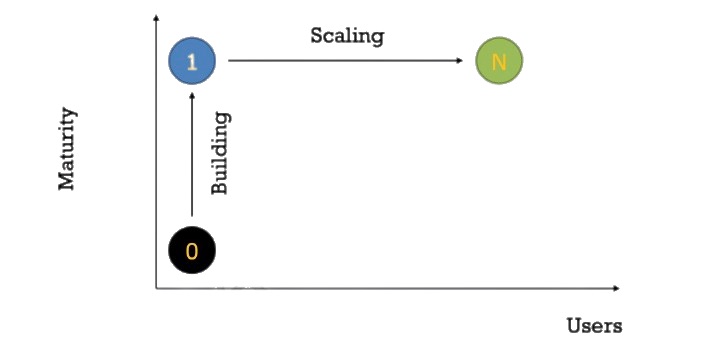In the world of business, there’s a delicate balance between innovation and growth. Two key phases often define an entrepreneurial journey: “Building from 0 to 1” and “Scaling from 1 to N.” In this article, we’ll explore these phases, the importance of innovation, and why embracing early failure is a crucial part of the process.
Understanding the Phases
Building from 0 to 1: Innovating and Creating
In the “Building from 0 to 1” phase, entrepreneurs take their vision, concept, or idea and bring it to life. This is the phase where true innovation occurs, and it’s often characterized by:
- Visionary Thinking: Entrepreneurs in this phase are visionaries who seek to create something entirely new, challenging the status quo.
- Risk-Taking: Embracing risk is crucial in this phase as you’re venturing into uncharted territory.
- Experimentation: Expect to iterate and experiment, as innovation rarely happens without a few failures along the way.
This phase is aptly described by Peter Thiel as going from “zero to one.” It’s about creating something unique, solving problems in novel ways, and setting the foundation for what’s to come.
Scaling from 1 to N: Multiplying Impact
Once you’ve successfully built something unique, it’s time to think about growth. In the “Scaling from 1 to N” phase, you take your proven concept and replicate it, making it more efficient and accessible to a broader audience. Key characteristics of this phase include:
- Optimization: Focus on refining processes, improving efficiency, and reducing costs.
- Replication: Expand your reach by replicating your successful model to reach a larger audience.
- Growth Mindset: Think about how to grow and maintain the momentum you’ve built.
This phase is all about going from “one to many.” It’s where you scale your business to new heights while maintaining the essence of what made your idea successful in the first place.
Embracing Early Failure
In both phases, early failure is a natural part of the journey. Here’s why embracing failure is critical:
In the “Building from 0 to 1” Phase
- Learning Opportunities: Failures provide valuable lessons that help you refine your ideas.
- Resilience Building: Overcoming early setbacks can make you and your business more resilient.
- Innovation Catalyst: Failure often triggers creative problem-solving and innovation.
In the “Scaling from 1 to N” Phase
- Process Optimization: Early failures can highlight areas that need improvement in your scaling process.
- Adaptability: Learning from failures allows you to adapt your strategies for better results.
- Sustainable Growth: Understanding and addressing early issues is essential for long-term, sustainable growth.
The key to success in both phases is to “fail early and learn fast.” Failure isn’t the opposite of success; it’s a stepping stone toward it.
Real-World Example: PayPal – Navigating from 0 to 1 and Beyond
One of the most iconic examples of successfully navigating the “0 to 1” phase and then scaling from “1 to N” is PayPal. In the late 1990s, the financial technology landscape was vastly different from what we know today. PayPal’s founders, including Peter Thiel, Max Levchin, and Elon Musk, recognized the need for a digital payment system that would revolutionize online transactions.
0 to 1 Phase: Innovation and Creation
PayPal started as Confinity, a company specializing in developing security software for handheld devices. However, they quickly identified a more significant opportunity in the form of creating a secure online payment platform. The idea was to allow users to transfer money electronically, solving the complexities and inefficiencies of online payments. This transition marked their “0 to 1” moment.
Key Takeaway: Embracing innovation and boldly pivoting your business model can lead to groundbreaking ideas.
1 to N Phase: Scaling and Market Domination
Once PayPal established itself as a secure online payment platform, it entered the “1 to N” phase with tremendous ambition. They scaled rapidly, attracting millions of users. The platform became the standard for online transactions, transforming how people conducted business and e-commerce.
In 2002, PayPal was acquired by eBay, a move that further solidified its dominance. The acquisition allowed eBay sellers to offer PayPal as a payment method, expanding its reach and usability.
Key Takeaway: Efficient scaling and market domination can follow a successful innovation when you’re prepared to seize the opportunity.
Embracing Early Failure
PayPal’s journey was not without its share of early failures and setbacks. For example, before the company achieved success, it faced challenges with fraudulent transactions and legal issues. However, these setbacks served as valuable lessons and drove PayPal to enhance security measures and compliance, ultimately improving the platform’s reliability and trustworthiness.
Key Takeaway: Embracing early failures as opportunities for growth and learning can lead to long-term success, even for industry giants like PayPal.
PayPal’s remarkable journey from an innovative idea to a globally recognized payment giant demonstrates the power of innovation, scaling, and learning from early failures. It serves as an inspiration for entrepreneurs looking to make their mark in the world of business.
Finding the Balance
To master the art of building and scaling, it’s crucial to find the right balance between these two phases. Understand when to innovate and when to optimize. Your approach should be tailored to your unique circumstances and goals. In today’s dynamic business environment, adaptability and a dynamic strategy are key to success.
In conclusion, the journey from 0 to 1 and from 1 to N is a dynamic one. Building and scaling are two sides of the same coin, and early failure is a critical ingredient for long-term success. Embrace innovation, learn from your mistakes, and always strive to create something unique and scale it effectively.
